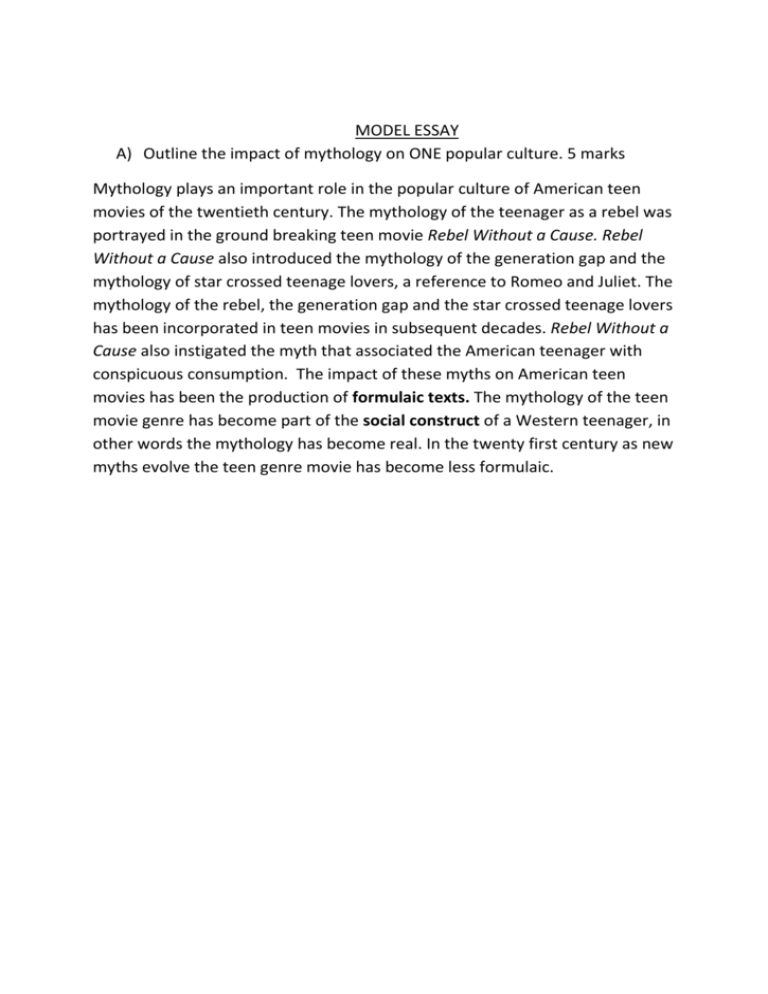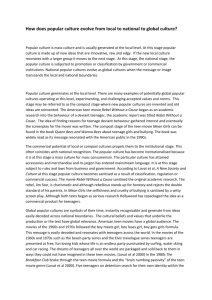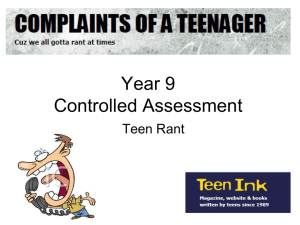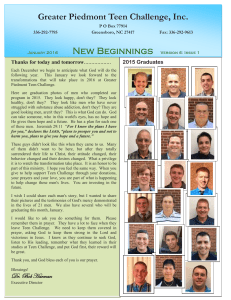Popular Culture model essay 2
advertisement

MODEL ESSAY A) Outline the impact of mythology on ONE popular culture. 5 marks Mythology plays an important role in the popular culture of American teen movies of the twentieth century. The mythology of the teenager as a rebel was portrayed in the ground breaking teen movie Rebel Without a Cause. Rebel Without a Cause also introduced the mythology of the generation gap and the mythology of star crossed teenage lovers, a reference to Romeo and Juliet. The mythology of the rebel, the generation gap and the star crossed teenage lovers has been incorporated in teen movies in subsequent decades. Rebel Without a Cause also instigated the myth that associated the American teenager with conspicuous consumption. The impact of these myths on American teen movies has been the production of formulaic texts. The mythology of the teen movie genre has become part of the social construct of a Western teenager, in other words the mythology has become real. In the twenty first century as new myths evolve the teen genre movie has become less formulaic. B) How have stakeholders perpetuated the myths over time? 8 marks Stakeholders include the motion picture companies that produce the texts for the market place. Teen movies can be considered in terms of two economies, “the financial economy of production and the cultural economy of consumption”. The first economy is concerned with profit. The second economy is concerned with the exchange of “cultural meanings and social identities”. Myths create “cultural meanings and social identities” (Fleming L. Fleming Y., Excel Society and Culture 2002 p121). Stakeholders also include the consumers of the teen movies, the teenagers. Teenagers consent to the power and authority of the motion picture companies when they consume their products. This is referred to as hegemony. (Fleming L. Fleming Y., Excel Society and Culture 2002 p122) Myths are perpetuated by constant cross referencing across the teen movie genre. The teenager as a rebel is a twentieth century myth easily decoded by teenagers. The rebel appears in Rebel Without a Cause, Ferris Bueller’s Day Off, The Breakfast Club and Ten Things I Hate About You. This myth has been perpetuated by presenting the rebel as a misunderstood teenager. The teenager is able to identify with the rebel not only because he is misunderstood but because invariably he has some noble qualities. The rebel needs something or someone to rebel against and in the American teen movie genre authority figures provide the necessary point of conflict. The myth of the generation gap is constantly cross referenced. In teen movies of the twentieth century parents and teachers appear as inept. Their ineptitude provides both pathos and humour. In Rebel Without a Cause the emasculation of Jim Stark’s father is the driving force of Jim’s actions. Jim engages in risk taking behaviour to avoid the emasculation experienced by his father. In Ferris Bueller’s Day Off and The Breakfast Club teachers are figures of fun providing comedy that appeals to teenagers on two levels, firstly the slap stick nature of the comedy and secondly empowering the teenager as they project their identity on to the teenage character in the movie. In Ten Things I Hate About You the well meaning but over protective father is easily decoded by many teenagers and provides the comedy of the text. Screen writers, producers and directors of the motion picture companies invariably introduced the mythology of star crossed lovers into the American teen movie genre of the twentieth century. Grease, The Breakfast Club and Ten Things I Hate About You cross reference this myth. The rebel, the male protagonist, sweeps the upper class girl off her feet, he fails to meet her expectations due to peer pressure but in the end his noble spirit and rebellious swagger win her over. Star crossed lovers provide the formula of the texts, boy meets girl, boy loses girl, boy wins girl back. Generally boy wins girl back on ‘prom’ night. Stakeholders also use American material culture to perpetuate myths. Across the decade texts in this genre have presented the teenager driving a ‘dream’ car and living in a two story house with a ‘white picket fence’. Stakeholders also use product placement to perpetuate myths, particularly the myth that American teenagers have an endless supply of disposable income. There is significant product placement of cars and fashion labels. The placement of Coca Cola or Pepsi in teen genre movies cross references the movie to the soft drink advertising. Coca Cola and Pepsi advertising is always directed at the youth market with images of freedom, fun and inclusion. C) Discuss future directions for the popular culture. 12 marks Future directions for American teen movies can be gauged by analysing trends in the genre. All popular culture passes through a compost stage, in this stage old ideas are recycled. Therefore future directions will include values, norms and myths presented in previous texts. Over the past sixty years American teen movies have had strong female characters from Pink Ladies to mean girls. Judy in Rebel Without a Cause, Molly in The Breakfast Club and Kat in Ten Things I Hate About You are all strong characters. This trend has continued in the most contemporary teen genre movie Juno. Therefore it is anticipated that future texts will portray strong female characters. However within the genre of American teen movies is a subset referred to as ‘gross out’ teen movies. This subset is represented by the Porkies trilogy, the American Pie trilogy and more recently Superbad. This subset within the genre uses crass language and behaviour and objectifies teenage girls. This trend will no doubt continue into the future as ‘gross out’ movies enjoy box office success. The mythology associated with twentieth century texts such as the rebel and the subsequent generation gap appears to be losing resonance. The mythology of conspicuous consumption of the American teenager was most evident in the 1990s. There had been references to this myth in Rebel Without a Cause, Ferris Bueller’s Day Off, Clueless and Mean Girls but this myth seems to have lost relevance in contemporary texts. The reality of movies made for Youtube have influenced institutionalised texts and will perhaps influence future texts. Twenty first century teen movies have as yet avoided the nostalgia teen movie. Grease, American Graffiti and Almost Famous reinforced the mythology of previous decades and in so doing reinforced the social construct of the Western teenager. Future nostalgia teen movies will encapsulate the mythology of the turn of the century teenager and reinforce the new mythology and eventually these myths will become real. Teen movies are agents of social change and agents of social control and play an important role in the socialisation of teenagers. The impact of the texts on teenagers of the future will increase as technology changes and teenagers are able to access the genre easily and cheaply. “It [popular culture} is the ground on which consent is won or lost. It is the theatre in which the interplay between power and consent is acted out” (Fleming L. Fleming Y., Excel Society and Culture 2002 p122). This is true of American teen movies and as a result of technological changes will continue to be true of this popular culture in the future. Plan A) Outline the impact of mythology on ONE popular culture. 5 marks Outline the mythologies: the teenager as a rebel the generation gap star crossed teenage lovers conspicuous consumption Impact - The impact of these myths on American teen movies has been the production of formulaic texts. B) How have stakeholders perpetuated the myths over time? 8 marks Define stakeholder. Myths are perpetuated by constant cross referencing across the teen movie genre. Give examples cross referencing of the teenager as a rebel - Rebel Without a Cause, Ferris Bueller’s Day Off, The Breakfast Club and Ten Things I Hate About You Give examples of cross referencing the generation gap - Rebel Without a Cause, Ferris Bueller’s Day Off, The Breakfast Club and Ten Things I Hate About You Give examples of cross referencing star crossed teenage lovers - Grease, The Breakfast Club and Ten Things I Hate About You Give examples of cross referencing conspicuous consumption and product placement C) Discuss future directions for the popular culture. 12 marks Future directions for American teen movies can be gauged by analysing trends in the genre. Compost culture and the future of American teen movies The future of gender relationships in American teen movies including a reference to ‘gross out’ subset. The future of 20th century myths in American teen movies such as the teenager as a rebel, the generation gap, star crossed teenage lovers and conspicuous consumption The impact of nostalgia movies on future teen movies The impact of technology on future teen movies







